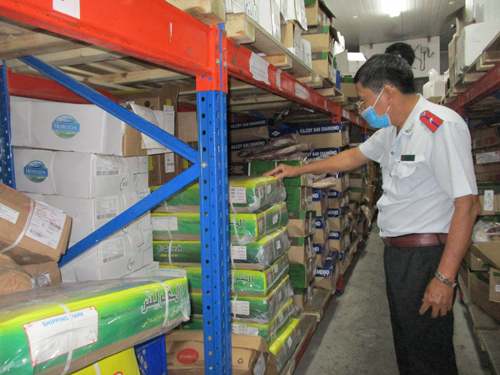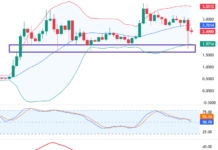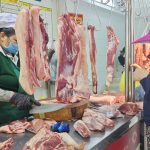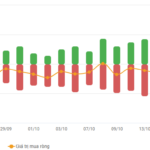The Vietnamese pork market has seen a recent surge in prices, with piglet prices ranging from VND 65,000 to 66,000 per kg, reflecting an increase of VND 5,000 to 6,000 per kg compared to late October.
Rebound in Domestic Pork Prices
Mr. Nguyen Tri Cong, Chairman of the Dong Nai Livestock Association, shared that pig farmers are currently profiting from the prevailing market prices. “While farmers naturally aspire for higher prices to maximize their gains, it is essential to strike a balance between their interests and those of consumers by maintaining moderate price levels,” he added. As domestic pork prices rise, imports will likely increase to cool down the market, Mr. Cong explained.

Frozen meat stocks in Ho Chi Minh City enterprises. Photo: AN NA
Customs statistics reveal that pork imports for the first ten months of 2024 reached nearly 85,000 tons, valued at almost $192 million. This signifies a decrease of 17.8% in volume and a 23.9% drop in value compared to the same period in 2023. The average price stood at $2,262 per ton (approximately VND 57,000 per kg), a 7.5% decline year-over-year.
Vietnam’s pork supply originates from a diverse range of markets, with Brazil, Russia, Canada, Germany, and the Netherlands being the top five suppliers, contributing 39%, 30%, 7.45%, 6%, and 4% respectively.
Mr. Cong emphasized that import businesses only engage in imports when there are profits to be made, rather than aiming to dominate the market. He stressed the importance of controlling the import of by-products and offal to protect both consumers and domestic livestock producers.
The director of a food processing plant in Binh Duong Province revealed that their company utilizes both domestic and imported sources, with comparable price points. For instance, the price of meat from the US and Brazil is VND 78,000 per kg, while pork belly from Russia is priced at VND 85,000 per kg, based on container purchases of approximately 20 tons.
On the other hand, the company exclusively imports pig trotters due to their significantly lower price (around VND 45,000 per kg) compared to domestic options. These imported trotters are used to produce products such as smoked ham and salted pork.
“Imported meat prices tend to be more stable, whereas domestic meat prices fluctuate, making it challenging to lock in output prices,” the company representative added.
Mr. Nguyen Thai Binh, who operates a high-end restaurant chain in Ho Chi Minh City, shared that their establishments prioritize the use of fresh and sweet-tasting domestic pork to ensure the best flavor in their dishes.
Mr. Binh also noted that frozen pork is predominantly used in casual dining establishments, fast-food outlets, and quick-consumption product manufacturers, while high-end restaurants rarely incorporate it into their menus. In contrast, imported beef is widely used in the restaurant industry due to the insufficient domestic supply.
Setbacks in Buffalo and Cattle Farming
Detailed data published by the Import-Export Department (under the Ministry of Industry and Trade) revealed that as of October, import volumes had increased for all meat categories except for chilled or frozen pork.
During this period, Vietnam imported 159,480 tons of meat from India, valued at $531.5 million. This signifies a 13% increase in volume and a 28% surge in value compared to the previous year. Consequently, the price of imported meat (primarily buffalo meat) from India was approximately $3,333 per ton, equivalent to VND 84,000 per kg. In stark contrast, domestic beef prices range from VND 200,000 to 250,000 per kg.
This significant price disparity has been a primary factor contributing to the challenges faced by Vietnam’s buffalo and cattle farming industry in recent times.
According to a report by the Ministry of Agriculture and Rural Development, buffalo and cattle farming have been on a downward trend due to their relatively low economic efficiency. Additionally, natural grazing areas have been shrinking in many localities, prompting farmers to shift towards other types of livestock farming. As a result, the national buffalo herd decreased by 3.1% to approximately 2.2 million head in November, while the cattle herd contracted by 0.4% to 6.4 million head.
Recently, Vu Yen Livestock Import-Export Company (based in Dong Nai) sent a distress call to the Governor of the State Bank of Vietnam and relevant authorities, requesting a debt repayment extension mechanism as they are currently facing “overdue debt” amounting to VND 100 billion.
Ms. Pham Thi Phuong, the company’s director, explained that their farm currently houses approximately 1,300 cattle worth around VND 23 billion. However, with a two- to three-year debt moratorium, the value of these cattle could potentially increase to VND 50 billion. “Additionally, we need time to find suitable partners to sell our land at a reasonable price to repay part of the principal to the banks,” she added.
Ms. Phuong attributed the company’s difficulties to the post-COVID-19 challenges and unfair competition from smuggled cattle injected with growth stimulants and frozen buffalo meat sold under the guise of cheap beef.
Mr. Nguyen Tri Cong acknowledged that Vu Yen Company had invested in a well-organized and closed-loop cattle farming system. However, their business faced setbacks due to the market being flooded with smuggled cattle fattened with banned substances and low-quality frozen buffalo meat, including dairy buffalo of inferior quality and at low prices.
With clean cattle farming costs ranging from VND 70,000 to 75,000 per kg, and market prices hovering between VND 65,000 and 70,000 per kg, the company struggled to remain competitive.
Previously, a large-scale, multi-industry corporation that successfully ventured into pig and layer chicken farming encountered challenges in the beef segment, with their current herd size falling short of the intended scale of over 10,000 head.
Surge in Piglet Exports to Hong Kong
Preliminary statistics from Vietnam Customs indicate that in the first ten months of 2024, Vietnam exported 18,610 tons of meat and meat products, valued at $83.74 million. This reflects a 2.8% increase in volume but a 5.9% decrease in value compared to the same period in 2023. Vietnam’s meat and meat product exports reached 35 markets, with Hong Kong (China) being the largest market, accounting for 62% of the total value.
The primary exports to Hong Kong consisted of frozen whole piglets and frozen whole pigs.






































